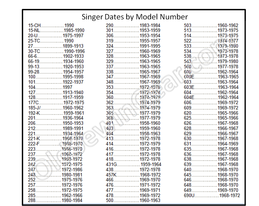6 Comments
Marianne
2/26/2014 02:57:37 pm
Where do I find the model number on a 1930s machine? Is there any way to find out what model a Singer is based on the serial number?
Reply
OldSewinGear
2/27/2014 11:35:57 am
Marianne,
Reply
confussed
9/9/2017 08:45:37 pm
why do you have to down load an app to get the info looking for
Reply
5/21/2019 07:10:30 am
What is the difference in model 620 and 635? I see a knob on the lower right that my old 620 did not have. What is the purpose of the knob?
Reply
SHEILA BARTON
8/2/2022 10:03:38 am
Thank you for your endeavours - hours of endless amusement!
Reply
7/7/2024 12:50:32 am
Some of the information is "less than correct".. I don't mean to sound "didactic", but in an "internet situation" correct information is crucial. People copy it and then it becomes "verbatim". The Singer # 401 machine was made starting in the year 1956 and production ended in 1961. One Million were made. There were more than "one run" of instruction manuals ( I have the 1956 and 1958 editions ). The #'s 403 and 404 machines were introduced in 1958 and the # 403 had a shorter production run, where the # 404 was produced until 1963.
Reply
Leave a Reply. |
News, Reviews,
|

 RSS Feed
RSS Feed